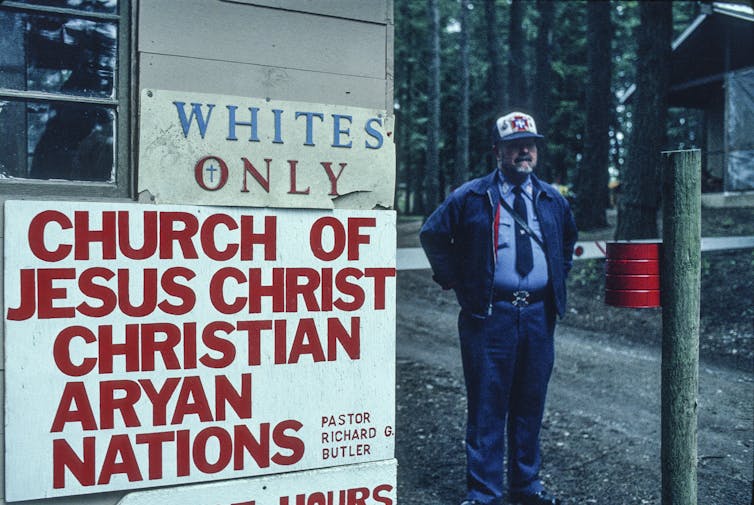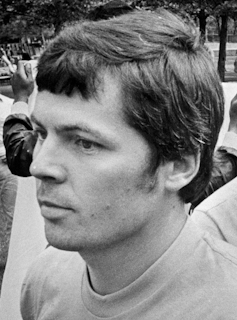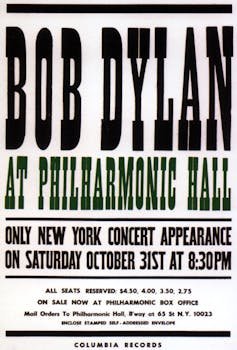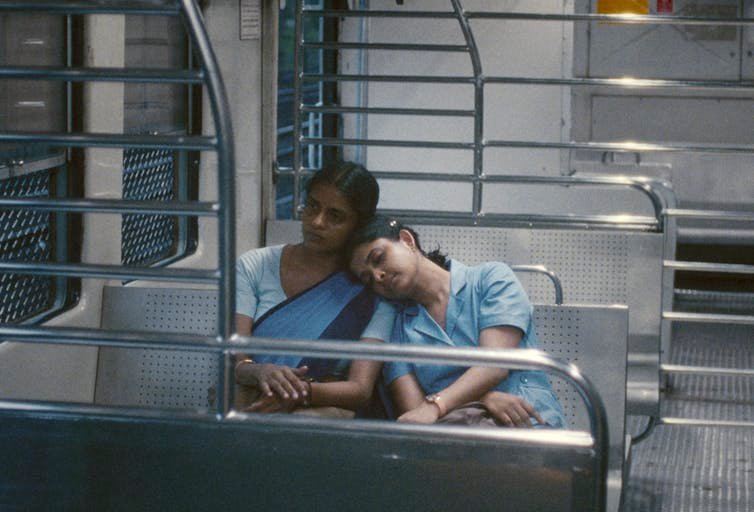Justin Kurzels’ new historical crime drama, “The Order,” starring Jude Law and Nicholas Holt, is being described as a riveting “cat-and-mouse thriller.”
But for criminologists like us, the white supremacist extremism that takes place in the film is not a nod to a distant past, but a reflection of beliefs and rhetoric that still percolate on social media and inspire acts of terror.
The film’s namesake, the real-life white supremacist group The Order, which operated in the early 1980s, laid the groundwork for many of the white power gangs that are active today.
The Order’s origins
The Order, also known as Brüder Schweigen, which is German for “The Silent Brotherhood,” was founded in 1983 by Robert “Bob” Mathews, an avid antisemite and white supremacist who held anticommunist and conspiratorial, anti-government beliefs.
A lifelong member of the John Birch Society and the Church of Jesus Christ of Latter-day Saints, Mathews joined the National Alliance, which was led by William Pierce, shortly after moving to the Pacific Northwest in 1974.
Pierce was arguably the era’s leading thinker in the white power movement and had authored “The Turner Diaries,” a dystopian work of fiction detailing a race war that became popular among the racist right.
At this point, Mathews also entered the orbit of another prominent figure in the white power movement, Richard Butler, while visiting Butler’s Aryan Nations compound in Hayden Lake, Idaho.

William F. Campbell/Getty Images
Butler was a patriarch of the Church of Jesus Christ Christian, a sect that was a racist and antisemitic perversion of mainstream Christianity. Each year, Butler hosted the Aryan Nations World Congress, a summit that brought together a potpourri of figureheads and groups from across the white power movement.
Shortly after the 1983 gathering, Mathews and eight other disillusioned white men – four of whom had served in the U.S. Armed Forces – formed The Order. Mathews wanted The Order to be the premier paramilitary strike force for the white power movement’s leadership. Their express purpose was to usher in a white supremacist society.
The Order was also a melting pot of white power ideology, with members recruited from the National Alliance, Aryan Nations, Ku Klux Klan, Christian Identity congregations, Posse Comitatus and the Covenant, the Sword, and the Arm of the Lord.
A blueprint for a race war
Mathews was no stranger to paramilitary groups.
A decade earlier, he had formed the short-lived Arizona Sons of Liberty to repel the “fomenting communist revolution” in America, with fellow Birchers and Mormon survivalists.
The Order, however, differed from the defunct Sons of Liberty in that it had an operational manual guiding its formation, structure and purpose: “The Turner Diaries.”
Using the novel as a guide, The Order’s strategy for preparing for a revolutionary race war involved raising money through counterfeiting and robbery; securing weapons; distributing funds to other white power groups; and embracing “leaderless resistance” to better avoid detection and infiltration by federal law enforcement. Even the group’s name was gleaned from the book’s fictional white power group, “the Organization.”

Steve Liss/Getty Images
Robbery, counterfeiting and murder
Originally, The Order attempted to rob drug dealers, pimps and sex workers.
But targeting them proved harder than anticipated. Their first successful armed robbery was of a pornographic video store, which netted them only US$369. The paltry sum prompted The Order to pursue more lucrative targets: armored cars and banks.
The group’s best haul came from a 1984 Brinks armored car robbery in Ukiah, California. The $3.6 million in cash that they stole was a then-record for an armored car heist.

Bettmann/Getty Images
The Order also engaged in counterfeiting, using a printing press at Richard Butler’s Aryan Nations compound in Idaho. Counterfeiting not only provided The Order with the cash it needed to fund its activities, but it also fulfilled its goal of undermining faith in the U.S. government by injecting phony money into the nation’s financial system.
There was one problem: The Order wasn’t very skilled at counterfeiting. Bruce Pierce, a member of The Order, was arrested for using the counterfeit $50 bills in Union Gap, Washington, in December 1983. Pierce subsequently posted bail and disappeared, which drew the attention of the FBI. Another member of The Order, Tom Martinez, was arrested for using the counterfeit $10 bills at a liquor store in June 1984.
The counterfeiting failures didn’t deter the group. Members simply shifted their focus to armed robbery.
The Order had also compiled a list of prominent targets for assassination that included financier Baron Elie de Rothschild, television producer Norman Lear, former Secretary of State Henry Kissinger, banker David Rockefeller and Morris Dees, the founder of the Southern Poverty Law Center.
Yet, instead of choosing a famous target, The Order decided to go after a Denver‐based, Jewish disc jockey named [Alan Berg]. Berg routinely berated far‐right callers on his radio show, including David Lane, a member of The Order. Berg was assassinated outside his home in June 1984. While four members of the Order were charged with the murder, only two, Bruce Pierce and David Lane, were convicted.
It all falls apart
Just like many white supremacist groups, The Order never achieved its principal goal of starting a race war and establishing a white homeland.
Tom Martinez, one of the members who had been caught using counterfeits, became an FBI informant after learning of Mathews’ plan to murder the liquor store owner to prevent him from testifying about the counterfeit money. Soon thereafter, Mathews burned to death during a standoff with law enforcement, and another 10 members were charged under racketeering statutes, causing the group to fall apart.

The Denver Post/Getty Images
Yet The Order’s legacy lives on.
First, The Order hardened the far-right’s revolutionary orientation by promulgating the conspiracy that Western governments are under the control of the Zionist Occupation Government, or ZOG – a supposed cabal of Jewish elites. While this conspiracy theory has roots back to the faked Protocols of the Elders of Zion, The New York Times’ coverage of The Order brought national attention to the group’s crimes, and how they had been committed in order to raise money to fight ZOG. The mainstreaming of this terminology helped spread these conspiracy theories.
Second, David Lane, one of the founding members of The Order, authored what became one of the most prolific mantras in the white power movement: “We must secure the existence of our people and a future for white children.” Known simply as the “14 Words,” Lane’s clarion call is regularly cited in white power propaganda, memes and publications to this day.
Lastly, The Order was often called a neo-Nazi terrorist group because of its white power ideology. But the lack of domestic terrorist statutes in U.S. law meant The Order’s members were primarily convicted of racketeering and conspiracy. Even the death of Berg resulted in only two members of The Order being convicted of violating Berg’s civil rights, not murder.
Most state-level terrorism statutes were not created until after the 9/11 attacks, and to this day, there is no federal domestic terrorism law. To us, the government’s failure to treat domestic extremists like The Order as terrorists downplays the consequences of their violence.
Local law enforcement passes the buck
The coordination and ideological rigor of The Order made them an outlier among white supremacist groups.
Interestingly, we’ve found that the ongoing assumption that white supremacist and neo-Nazi groups are structurally organized and always ideologically driven has diverted the attention of local law enforcement.
Rather than treating these groups more like street gangs, local police will often cede their law enforcement duties to the federal government. But since today’s white power gangs, such as Proud Boys or Rise Above Movement, primarily operate out of local communities, we believe local law enforcement can do a much better job tracking members and deterring violence, since they – not federal agents – are more knowledgeable about group dynamics and more familiar with their criminal activities.
Research indicates that systematically monitoring and targeting groups that exhibit violent behavior deters future acts of violence. In our view, local law enforcement’s inattentiveness is a key reason that white supremacists and other domestic extremists have become the most “persistent and lethal threat” in the U.S., as the Department of Homeland Security noted in a 2020 report.










